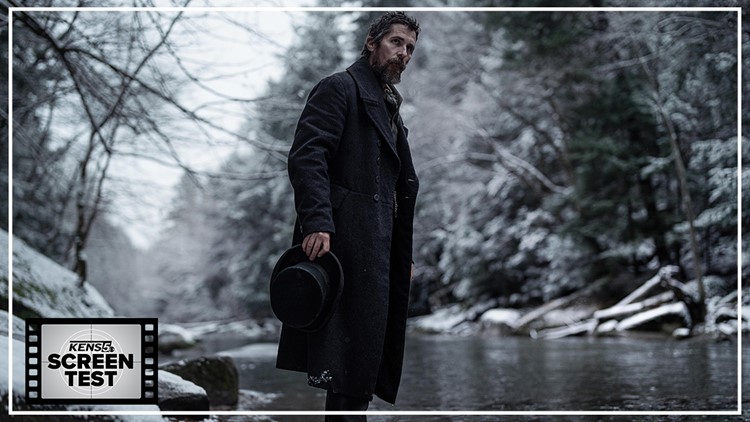TEXAS, USA — Charged with just enough madness to make you wonder whether it would make more sense as a particularly prestigious Shudder offering or an especially chilly Netflix project, “The Pale Blue Eye” nonetheless arrives on the latter platform Friday to remind us that historical writers are just as capable of becoming intellectual property as the fictional heroes transposed to the big screen every few months. This movie isn't likely to become a franchise, but it plays with your knowledge of its famous poet regardless.
In Scott Cooper’s creepy, drawn-out thriller-turned-unlikely origin story, the writer in question is Edgar Allan Poe (Harry Melling, in a stupendously strange performance begging to be closely evaluated). But this isn’t the Poe you’re likely picturing; Melling’s young legendary-author-to-be is a babyfaced West Point cadet whose name hasn’t yet been immortalized, who’s more interested in lewd rhymes than stories of deadly pendulums and tell-tale hearts. It’s a defense mechanism to amuse the fellow cadets armed and ready to bully him, his outsider status otherwise motivating this downtrodden young Edgar to impress a detective (played by Christian Bale) hired to look for whoever ripped the heart from a dead soldier’s chest.
Organs may not divulge secrets in “The Pale Blue Eye” – the meaning of which is divulged in one of the film's more emotionally charged scenes – but a steady diet of sleuthing and sneaking eventually does. Far from the riotous fun of Netflix roommate “Glass Onion, “The Pale Blue Eye” is a peculiar and dour whodunnit that's instead more of apiece with the Guillermo del Toro-produced "Cabinet of Curiosities" series. The movie's underlit presentation of wintry 1830s Hudson Valley is increasingly overcome with a masque of frosty dread, and concerns of the occult variety enter the fray as fear clamps down on the academy population. You won’t necessarily get those goosebumps, but you might feel a slight chill of surprise; English-language Netflix projects rarely feel as menacing as this, even if the danger more often than not leers from a distance.
Edgar and August make for a compelling central pair, not in the least because Melling has emerged as one of the more daring young alumni of the “Harry Potter” films. Here, Dudley Dursley’s syrupy dollop of a Southern accent holds its own against an Oscar-winning chameleon whose own performance is an exercise in barely concealed fragility. Their veteran-mentee dynamic grounds two characters traveling similar journeys of grief on contrasting paths; the most effective stroke of Cooper’s script (adapting a 2003 novel by Louis Bayard) weaponizes our assumptions of his leads, flip-flopping sympathies until the dividing line has been gutted. “The Pale Blue Eye” emerges in a terrain more morally complicated than that which it set out on, and comes to be a mystery less concerned with the identity of a killer than the conditions which emboldened them.
Occupying an especially glum overlap in the Venn diagram of “Sherlock Holmes” and “Zodiac,” Cooper’s film feigns an anti-institutional fury that most strongly manifests in the dissonance between the blasé attitudes of this academy’s head honchos (particularly Timothy Spall, doing his best Ben Mendelsohn impression) and the overwhelming machinery they’re operating within. Bale, of course, knows a thing or two about playing gruff personalities with tragic backstories, and he navigates the world with grim allure and hoarse whispers that dissipate as slowly as dark smoke plumes. Suspects are at once everywhere and nowhere in “The Pale Blue Eye,” and if you find yourself squinting at your TV set (best watch this at night) it might be because tangential characters are only as shaded-in as the motives we easily assign to them (apologies to Lucy Boynton’s Lea Marquis, the apple of lovesick Edgar’s eye). The movie’s grim atmosphere – fueled by the sensation that our detectives are crawling into their own insides the closer they get to answers – is instead turned captivating through the vagueness of its ideas, and sometimes because those ideas haven’t been as thought-out as cinematographer Masanobu Takayanagi’s attempts to turn this wintry hellscape into its own nightmare.
For much of its 130-minute runtime, “The Pale Blue Eye” appears invested in being the kind of movie that, true to the writer Edgar will become, embraces obscurity over logic; it’s that tradeoff that gives heft to its darkness both physical and spiritual. It feels shortsighted, then, when Cooper extends his film a good 15 minutes beyond the life expectancy of his themes, partially collapsing them with a final twist of the knife and introducing narrative fussiness to a film that found its groove in the wretched nature of that which can’t be explained.
"The Pale Blue Eye" is rated R for some violent content and bloody images. Now streaming on Netflix. Runtime: 2 hours, 8 minutes.
Directed by Scott Cooper; written by Scott Cooper from the novel by Louis Bayard
Starring Christian Bale, Harry Melling, Simon McBurney, Timothy Spall
2023
---
>MORE REVIEWS:



